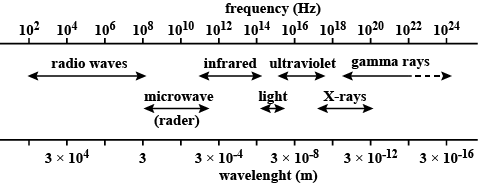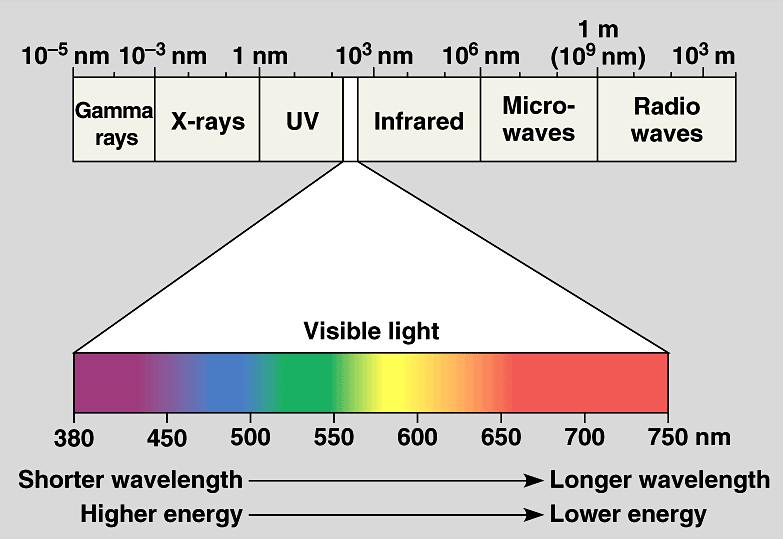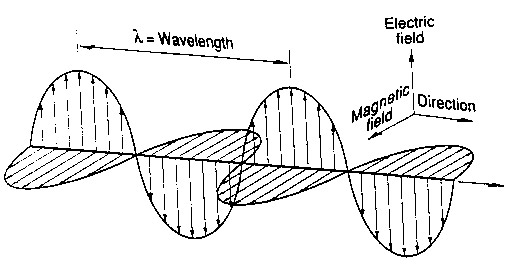Q.1.
Which of the following are not electromagnetic waves?
-
0%
cosmic rays
-
0%
gamma rays
-
0%
$$\beta$$-rays
-
0%
X-rays
Q.2.
The frequency $$2\:MHz$$ belongs to:
-
0%
visible light
-
0%
X-rays
-
0%
microwaves
-
0%
radiowaves
Q.3.
A plane electromagnetic wave is incident on a material surface. If the wave delivers momentum $$p$$ and energy $$E$$, then:
-
0%
$$p=0$$, $$E=0$$
-
0%
$$p\ne0$$, $$E\ne0$$
-
0%
$$p\ne0$$, $$E=0$$
-
0%
$$p=0$$, $$E\ne0$$
Q.4.
In the propagation of electromagnetic waves, the angle between the direction of propagation and plane of polarisation is
-
0%
0$$^0$$
-
0%
45$$^0$$
-
0%
90$$^0$$
-
0%
180$$^0$$
Q.5.
Which of the following has/have zero average value in a plane electromagnetic wave?
-
0%
Both magnetic and electric field
-
0%
Electric field only
-
0%
Magnetic energy
-
0%
Electric energy
Q.6.
Which of the following statements is correct?
-
0%
Ultrasonic waves can travel in vaccum.
-
0%
Wavelength of ultrasonic waves of the same order as that of microwaves.
-
0%
Frequency of ultrasonic waves is of the same order as that of x-rays.
-
0%
Speed of ultrasonic waves is of the same order as that of light.
Q.7.
The visible part of electromagnetic spectrum lies in between
-
0%
X -ray and ultra-violet
-
0%
Ultra violet and infra red
-
0%
Infra red and microwave
-
0%
X-ray and infra red
Q.8.
Earth's atmosphere is transparent for
-
0%
only the visible light
-
0%
only the X-rays
-
0%
only the $$\gamma$$- rays
-
0%
visible light and microwaves
Q.9.
The oscillating electric and magnetic vectors of an electromagnetic wave are oriented along
-
0%
the same direction but differ in phase by $$90^\circ$$.
-
0%
the same direction and are in phase.
-
0%
mutually perpendicular directions and are in phase.
-
0%
mutually perpendicular directions and differ in phase by $$90^\circ$$.
Q.10.
For transmission of e.m.wave of audible frequency, these waves are superimposed with waves of:
-
0%
frequency less than $$20\:Hz$$
-
0%
frequency less than $$10\:KHz$$
-
0%
frequency in the audible range
-
0%
radio-frequency
Q.11.
For a radio transmission, radio wave reaching the ionized medium:
-
0%
will bend away from normal.
-
0%
will bend towards normal.
-
0%
will bend follow a straight-path.
-
0%
None of the above.
Q.12.
The frequency of the visible light of wave length $$6000 A.U.$$ (Angstrom units) is
-
0%
$$4 \times {10}^{14} Hz$$
-
0%
$$6000$$
-
0%
$$5 \times {10}^{10} Hz$$
-
0%
$$5 \times {10}^{14} Hz$$
Q.13.
Which of the following effects could not be explained by Maxwell's electromagnetic wave theory?
-
0%
Photoelectric effect
-
0%
Compton effect
-
0%
Raman effect
-
0%
All of these
Q.14.
Consider the following processes
(i) Electrical oscillation
(ii) Rapid deceleration of fast electrons
(iii) Atomic transition
Which of these are likely to produce visible light?
(i) Electrical oscillation
(ii) Rapid deceleration of fast electrons
(iii) Atomic transition
Which of these are likely to produce visible light?
-
0%
(iii) only
-
0%
(ii) and (iii)
-
0%
(i) and (iii)
-
0%
(i), (ii) and (iii)
Q.15.
Which of the following lights has maximum wavelength?
-
0%
$$\gamma$$ - rays
-
0%
X - rays
-
0%
UV - rays
-
0%
Visible rays
Q.16.
The heat in solar radiation is mainly due to the presence of _______ .
-
0%
infrared radiations
-
0%
ultraviolet radiations
-
0%
visible light
-
0%
x-rays
Q.17.
Les-energetic electromagnetic radiations like X-rays are generated in the
-
0%
Radiation zone
-
0%
Convection zone
-
0%
Photosphere
-
0%
Chromosphere
Q.18.
Which of the following is/are not electromagnetic waves?
-
0%
$$\beta$$ -rays
-
0%
X-rays
-
0%
Cosmic rays
-
0%
Both (a) and (c)
Q.19.
According to the electromagnetic wave theory, light consists of electric and magnetic fields which are __________.
-
0%
parallel to each other
-
0%
perpendicular to each other
-
0%
inclined at an angle of $${45}^{o}$$ to each other
-
0%
none of these
Q.20.
In an electromagnetic spectrum, if the rays are placed in increasing order with respect to wavelength (i.e., from lower to higher wavelength); The following order is correct
-
0%
Radiowaves, microwave, infrared rays
-
0%
Gamma ray, X-ray, ultraviolet ray
-
0%
Ultraviolet ray, gamma ray, X-ray
-
0%
Microwave, infrared rays, radiowaves
Q.21.
What is common in all components of spectrum in white light
-
0%
Wavelength
-
0%
Frequency
-
0%
Speed
-
0%
A and B
Q.22.
Which of the following conclusion can be drawn from the result $$\oint \bar{B}\cdot d\bar{A}=0$$
-
0%
Magnetic field is zero everywhere
-
0%
Magnetic monopole cannot exist
-
0%
Magnetic lines of force do not intersect each other
-
0%
A current produces magnetic field
Q.23.
Assertion: Dipole oscillations produce electromagentic waves,
Reason : Accelerated charge produces electromagnetic waves
Reason : Accelerated charge produces electromagnetic waves
-
0%
If both assertion and reason are true but the reason is the correct explanation of assertion.
-
0%
If both assertion and reason are true but the reason is not the correct explanation of assertion.
-
0%
If assertion is true but reason is false.
-
0%
If both the assertion and reason are false.
-
0%
If reason is true but assertion is false.
Q.24.
UV Rays are useful for
-
0%
Sterilizing purposes
-
0%
Detecting purity of gems, ghee, etc
-
0%
Producing Vitamin D in food of plants and animals
-
0%
All of the above
Q.25.
A parallel plate capacitor is charged to $$60 \mu C$$. Due to a radioactive source, the plate loses charge at the rate of $$1.8\times 10^{-8}C/s$$. The magnitude of displacement current is:
-
0%
$$1.8\times 10^{-8}C/s$$
-
0%
$$3.6\times 10^{-8}C/s$$
-
0%
$$4.1\times 10^{-11}C/s$$
-
0%
$$5.7\times 10^{-12}C/s$$
Q.26.
Frequency of infrared wave is approximately:
-
0%
$$\displaystyle { 10 }^{ 18 }Hz$$
-
0%
$$\displaystyle { 10 }^{ 14 }Hz$$
-
0%
$$\displaystyle { 10 }^{ 9 }Hz$$
-
0%
$$\displaystyle { 10 }^{ 16 }Hz$$
Q.27.
The pressure exerted by an electromagnetic wave of intensity $$\displaystyle I\left( { watt }/{ { m }^{ 2 } } \right) $$ on a non-reflecting surface is : [c is the velocity of light]
-
0%
$$\displaystyle Ic$$
-
0%
$$\displaystyle { Ic }^{ 2 }$$
-
0%
$$\displaystyle { I }/{ c }$$
-
0%
$$\displaystyle { I }/{ { c }^{ 2 } }$$
Q.28.
A certain color of light towards the purple end of the visible spectrum has a wave length of $$420\, nm$$ in vacuum.
What is the frequency of this light? (The speed of light in a vacuum is $$3.00 \times 10^8 \, m/s$$).
What is the frequency of this light? (The speed of light in a vacuum is $$3.00 \times 10^8 \, m/s$$).
-
0%
$$126\, Hz$$
-
0%
$$1.26 \times10^{11} \, Hz$$
-
0%
$$7.1 \times 10^{14} \, Hz$$
-
0%
$$1.4 \times 10^{15} \, Hz$$
-
0%
$$1.4 \times 10^{6} \, Hz$$
Q.29.
Cavitation is a special application property exhibited only by:
-
0%
Ultrasonics
-
0%
Electromagnetic waves
-
0%
Audible sound
-
0%
Infrasonics
Q.30.
Calculate the wavelength of an X-ray whose frequency is $$1.0\times 10^{18}Hz$$.
-
0%
$$3.3 \times 10^{-11} m$$
-
0%
$$3.0 \times 10^{-10} m$$
-
0%
$$3.3 \times 10^{-9} m$$
-
0%
$$3.0 \times 10^{-8} m$$
-
0%
$$3.0 \times 10^{26} m$$
Q.31.
Identify which of the following wave has the longest frequency?
-
0%
Red light
-
0%
Blue light
-
0%
Gamma rays
-
0%
X rays
-
0%
Radio waves
Q.32.
Radiations of intensity 0.5 W/m2 are striking a metal plate. The pressure on the plate is
-
0%
$$0.166 \times 10^{-8} N/m2$$
-
0%
$$0.332 \times 10-8 N/m^2$$
-
0%
$$0.111 \times 10-8 N/m^2$$
-
0%
$$0.083 \times 10-8 N/m^2$$
Q.33.
Which of the following is the right derivation for Ampere-Maxwell law?
-
0%
$$\oint {\overrightarrow B}. \overrightarrow {dl} = {\mu}_0 i_c + 4\pi {\mu_0} {\varepsilon_0} \dfrac{d {\phi}_E}{dt}$$
-
0%
$$\oint {\overrightarrow B}. \overrightarrow {dl} = {\mu}_0 i_c + 3 {\mu_0} {\varepsilon_0} \dfrac{d {\phi}_E}{idt}$$
-
0%
$$\oint {\overrightarrow B}. \overrightarrow {dl} = {\mu}_0 i_c + {\mu_0} {\varepsilon_0} \dfrac{d {\phi}_E}{dt}$$
-
0%
$$\oint {\overrightarrow B}. \overrightarrow {dl} = {\mu}_0 i_c + \dfrac{{\mu_0}}{ {\varepsilon_0}} \dfrac{d {\phi}_E}{dt}$$
Q.34.
Which of the following statement(s) is/are correct?
-
0%
Conduction current obeys Ohm's law whereas displacement current does not.
-
0%
Conduction current is the actual current whereas displacement current is the apparent
current produced by time varying electric field. -
0%
Conduction current density is represented by $$\overrightarrow {J_c} = \sigma \overrightarrow E$$ whereas displacement current
density is given by $$ \overrightarrow {J_d} = \dfrac{ \overrightarrow{\delta E}}{\delta t}$$; $$\sigma $$= conductivity of the element, $$\overrightarrow E$$= electric field. -
0%
All of the above
Q.35.
A parallel plate capacitor consists of circular plates with radius $$10 cm$$ , separated by a distance of $$0.5mm$$. The capacitor is charged by an external source such that the electric field between the plates changes at a rate $$5 \times 10^{13} Vm{-1}s{-1}$$. The displacement current through the capacitor is
-
0%
$$1.4 mA$$
-
0%
$$14 mA$$
-
0%
$$14 A$$
-
0%
$$1.4 A$$
Q.36.
The radiations emitted by the sun and responsible for the cause of skin cancer are:
-
0%
infra-red
-
0%
X-rays
-
0%
micro-waves
-
0%
ultra-violet
Q.37.
In which of the following media can non-mechanical waves travel?
-
0%
In vacuum as well as in a medium
-
0%
In vacuum but not in a medium
-
0%
In a medium but not in a vacuum
-
0%
Neither in a medium nor in vacuum
Q.38.
A long spring is fixed at one end. A person holding the other end compresses the spring with a jerk. The compression travels along the length of the spring. Which kind of wave is travelled along the length of the spring?
-
0%
Electromagnetic waves
-
0%
Transverse waves
-
0%
Longitudinal waves
-
0%
Both (A) and (C)
Q.39.
Which of the following is not the characteristics of electromagnetic wave?
-
0%
The electric and magnetic fields $$\overrightarrow E$$ and $$\overrightarrow B$$ are always perpendicular to the direction in which the wave is travelling
-
0%
The electric field is always perpendicular to the magnetic field
-
0%
The cross product $$\overrightarrow E \times \overrightarrow B$$ always gives the direction in which the wave travels
-
0%
The fields do not vary simultaneously
Q.40.
A parallel plate capacitor with plate area A and separation between the plates $$d$$, is charged by a constant current $$i$$. Consider a plane surface of area $$\dfrac{A}{2}$$ parallel to the plate and down symmetrically between the plates. Find the displacement current through this area.
-
0%
$$i_d= \dfrac{i}{8}$$
-
0%
$$i_d= \dfrac{i}{2}$$
-
0%
$$i_d= \dfrac{i}{3}$$
-
0%
$$i_d= \dfrac{i}{4}$$
Q.41.
A $$1000\Omega $$ resistance and a capacitor of $$100\Omega $$ resistance are connected in series a $$220 V$$ source. when the capacitor is 50% charged, the value of the displacement current is.
-
0%
$$11.\sqrt{2}A$$
-
0%
$$2.2 A$$
-
0%
$$11A$$
-
0%
$$4.4A$$
Q.42.
Infrared radiations are used in
-
0%
Microwave ovens
-
0%
Long distance photography
-
0%
Microscopes
-
0%
Treatment of cancer
Q.43.
A parallel plate capacitor having plate area A and plate separation $$d$$ is connected to a battery of emf $$\varepsilon$$ and internal resistance $$R$$ at $$t=0$$. Consider a plane surface of area $$\dfrac{A}{2}$$, parallel to the plates and situated symmetrically between them. Find the displacement current through this surface as a function of time?
-
0%
$$\dfrac {\varepsilon}{2R} \ \ \ e^{\dfrac{-td}{\varepsilon AR}}$$
-
0%
$$\dfrac {2\varepsilon}{R} \ \ \ e^{\dfrac{-td}{\varepsilon AR}}$$
-
0%
$$\dfrac {5\varepsilon}{2R} \ \ \ e^{\dfrac{-td}{4 \varepsilon AR}}$$
-
0%
$$\dfrac {\varepsilon}{2R} \ \ \ e^{\dfrac{-td}{4\pi \varepsilon AR}}$$
Q.44.
Match the following .
-
0%
1,6,11,12
-
0%
1,6,11,12
-
0%
1,6,11,12
-
0%
1,6,11,12
Q.45.
The concept of displacement current introduced by Maxwell removes asymmetry between
-
0%
Gauss's law in electrostatics and Gauss's law in magnetism
-
0%
Faraday's law and Ampere' law
-
0%
Gauss's law and Ampere's law
-
0%
Gauss's law and Faraday's law
Q.46.
The dimensional formula of wave number is :
-
0%
$$[M^0L^0T^0]$$
-
0%
$$[M^0L^{-1}T^0]$$
-
0%
$$[M^0L^0T^{-1}]$$
-
0%
$$[M^{-1}L^{-1}T^0]$$
Q.47.
Choose the correct answer from alternatives given.
If $$\vec { E } $$ and $$\vec { B } $$ represent electric and magnetic field vectors of an electromagnetic wave, the direction of propagation of the wave is along
If $$\vec { E } $$ and $$\vec { B } $$ represent electric and magnetic field vectors of an electromagnetic wave, the direction of propagation of the wave is along
-
0%
$$\vec { B } \times \vec { E } $$
-
0%
$$\vec { B } $$
-
0%
$$\vec { E } $$
-
0%
$$\vec { E } \times \vec { B } $$
Q.48.
A. Current flow inside the capacitor due to accumulation of charges on the capacitor walls is called displacement current.
B. Current due to the flow of electrons due to some potential difference is called as conduction current.
C. Displacement current came into existence when Maxwell observed that if a magnetic compass is placed between the capacitors the needle gets deflected which signifies presence of magnetic fields which would possibly caused due to some changing current.
D. Displacement current change the actual motion of electric charges.
Which of the above statement(s) is/are correct?
B. Current due to the flow of electrons due to some potential difference is called as conduction current.
C. Displacement current came into existence when Maxwell observed that if a magnetic compass is placed between the capacitors the needle gets deflected which signifies presence of magnetic fields which would possibly caused due to some changing current.
D. Displacement current change the actual motion of electric charges.
Which of the above statement(s) is/are correct?
-
0%
A and B only
-
0%
A, B and C only
-
0%
C only
-
0%
A,B,C and D
Q.49.
According to Maxwell's hypothesis, changing of electric filed give rise to
-
0%
magnetic field
-
0%
pressure gradient
-
0%
charge
-
0%
voltage
Q.50.
A plane electromagnetic wave of frequency 20 MHz travels through a space along x direction. If the electric field vector at a certain point in space is 6 V $$m^{-1}$$, what is the magnetic field vector at that point?
-
0%
$$2\times 10^{-8}T$$
-
0%
$$\dfrac{1}{2}\times 10^{-8}T$$
-
0%
$$2T$$
-
0%
$$\dfrac{1}{2}T$$


